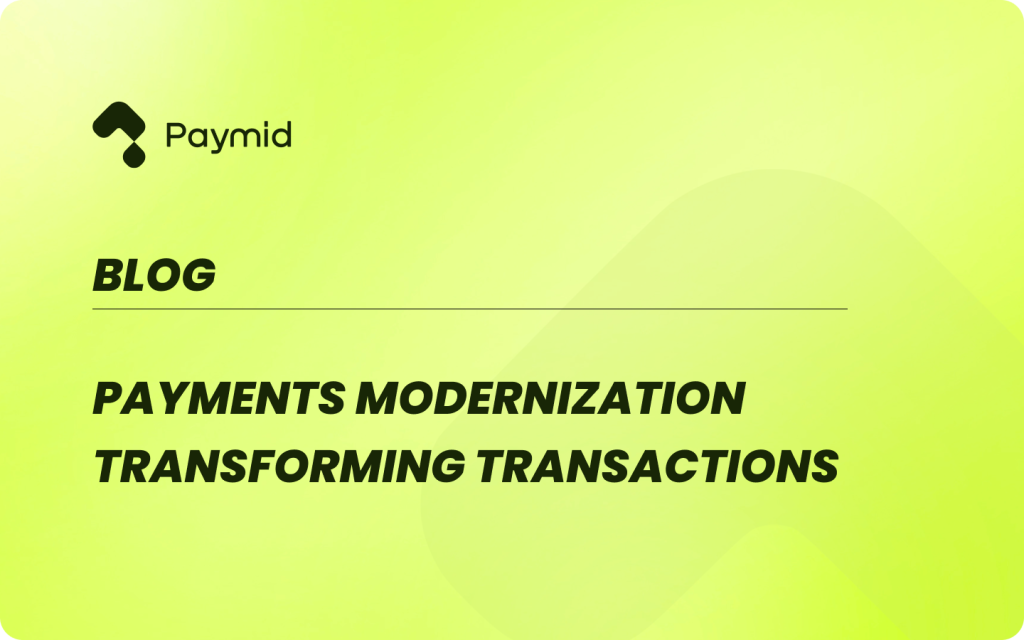Payments Modernization: Transforming Financial Transactions for the Future

Financial institutions process trillions of dollars in transactions daily through systems built decades ago. These legacy systems, while reliable, no longer meet the demands of today’s digital economy. Payments modernization has become essential for financial institutions to remain competitive and meet evolving customer expectations in an increasingly digital world[1].
The transformation of payment infrastructure requires a comprehensive approach that combines innovative payment technology with robust security measures. Modern payment systems leverage cloud computing, APIs, and real-time processing capabilities to create a more efficient and secure payment ecosystem.
- Financial institutions need to upgrade legacy payment systems to remain competitive and meet evolving digital demands, integrating cloud-based infrastructure, API frameworks, and real-time processing for efficiency and security.
- Payment transformation requires a phased, risk-managed approach with robust change management and resource allocation to ensure effective modernization without compromising operational stability.
- Modernized systems improve customer experience, lower operational costs, and enable new revenue streams, providing both immediate and strategic advantages for institutions adapting to the digital age.
The Evolution of Payment Systems
The payment landscape has undergone a remarkable transformation since the introduction of the first modern credit card in 1950. Traditional payment systems, while foundational to the financial industry, have increasingly shown their limitations in meeting contemporary business needs[2].
Traditional Payment Infrastructure Limitations
Legacy payment systems face several critical constraints that impact business efficiency and customer satisfaction:
- Manual reconciliation processes require significant documentation.
- Extended processing times for check payments and settlements.
- Higher operational costs compared to digital alternatives.
- Limited payment options and reduced transparency.
- Increased risk of theft and fraud in physical disbursements.
Rise of Digital Payment Solutions
The emergence of digital payment solutions has revolutionized financial transactions. Mobile wallets and digital payment platforms have gained significant traction, with projections indicating over 4.8 billion mobile wallet users by 2025[3]. The shift toward cashless transactions has been particularly pronounced in emerging economies, where mobile payments often represent the first introduction to digital financial services.
Impact of Technological Innovation
Technological advancement has fundamentally transformed payment systems through innovations in payment modernization. The integration of Near Field Communication (NFC), biometric authentication, and blockchain technology has enhanced both security and efficiency. Payment applications now leverage sophisticated infrastructure to enable real-time processing and cross-border transactions[4].
The payment transformation continues to accelerate with the introduction of new technologies and payment methods. Financial institutions are increasingly adopting cloud-based solutions and API frameworks to facilitate faster, more secure transactions. This evolution in payment technology has led to reduced transaction costs, improved fraud prevention, and enhanced customer experiences across both retail and commercial sectors.
Core Components of Modern Payment Systems
Modern payment systems are built on three fundamental pillars that enable financial institutions to process transactions efficiently while maintaining security and compliance. These components work in harmony to create a robust payment infrastructure that meets today’s digital demands[5].
Cloud-Based Architecture
The foundation of modern payments infrastructure relies on cloud technology that offers unprecedented scalability and flexibility. This architecture delivers several critical advantages:
- On-demand resource provisioning for handling transaction spikes.
- Globally distributed processing capabilities.
- Enhanced data storage and analytics capabilities.
- Reduced total cost of ownership.
- Improved disaster recovery and business continuity.
The cloud infrastructure enables financial institutions to optimize their payment technology stack while maintaining strict security protocols and regulatory compliance.
API Integration Framework
Modern payment infrastructure leverages APIs as the cornerstone of system connectivity. These interfaces serve as secure bridges between various payment components, enabling seamless communication between internal systems and external services. The API framework facilitates real-time data exchange, enriches customer experiences, and provides robust security through standardized protocols[6].
Financial institutions can now expose their payment systems through APIs, enabling third-party integration while maintaining control over core processing functions. This approach supports embedded payment solutions and creates new revenue opportunities through additional services.
Real-Time Processing Capabilities
The evolution toward instant payment processing represents a significant leap in payment modernization. Real-time processing systems operate continuously, enabling 24/7 transaction processing with immediate settlement. These capabilities support immediate funds transfer, instant notification, and enhanced cash flow management for businesses.
The implementation of real-time processing relies on sophisticated event streaming and microservices architecture. This design ensures individual transaction processing without batching, providing immediate confirmation and reducing transaction risk through instant settlement[7].
Implementation Strategies and Challenges
Successful implementation of payment modernization initiatives requires careful planning and a comprehensive understanding of potential challenges. Organizations must balance the drive for innovation with practical considerations of risk, resources, and organizational change.
Risk Assessment and Mitigation
Financial institutions implementing modern payment infrastructure must address several critical risk factors:
- Fraud prevention in real-time payment environments.
- Security vulnerabilities in API integrations.
- Compliance with evolving regulatory requirements.
- System downtime and business continuity risks.
- Third-party vendor management challenges.
Organizations should implement advanced analytics and machine learning solutions to enhance fraud detection capabilities while maintaining quick processing times. Regular security audits and stress testing help identify vulnerabilities before they can be exploited.
Resource Allocation and Timeline Planning
Effective resource allocation is crucial for payment transformation success. Organizations must carefully evaluate their current capabilities and determine necessary investments in technology and human capital. Strategic resource planning should consider both immediate implementation needs and long-term maintenance requirements[8].
Timeline planning requires a balanced approach between quick wins and comprehensive system updates. Rather than pursuing “big bang” implementations, organizations often find success with modular, phased approaches that allow for incremental progress and adjustment based on feedback and performance metrics.
Change Management Considerations
The human element of payment application modernization often presents the most significant implementation challenge. Organizations must develop comprehensive change management strategies that address both technical training needs and cultural adaptation to new systems.
Successful change management involves identifying and supporting “change champions” within the organization who can help drive adoption. Clear communication about the benefits of new payment technology helps overcome resistance to change and ensures stakeholder buy-in across all levels of the organization[9].
Implementation success depends on establishing clear governance frameworks and decision-making processes. Organizations should create dedicated teams responsible for monitoring progress, addressing challenges, and ensuring alignment with strategic objectives throughout the modernization journey.
Measuring Success and ROI
Measuring the success of payment modernization initiatives requires a comprehensive framework that combines quantitative metrics with qualitative assessments. Organizations must establish clear benchmarks to evaluate their investment returns and track progress toward strategic objectives[10].
Key Performance Indicators
Successful payment transformation relies on tracking specific metrics that indicate system performance and business impact. Organizations should monitor:
- Transaction Success Rates and Volumes.
- Payment Processing Speed and Settlement Times.
- System Uptime and Availability.
- Fraud Detection and Prevention Rates.
- Customer Satisfaction and Adoption Metrics.
These KPIs provide valuable insights into the effectiveness of new payment technology implementations and help identify areas requiring optimization. Regular monitoring enables organizations to make data-driven decisions about system improvements and resource allocation.
Cost-Benefit Analysis
A thorough cost-benefit analysis forms the foundation of ROI measurement in payment application modernization. Organizations must consider both direct costs, such as technology investments and implementation expenses, and indirect costs, including training and operational adjustments. The benefits assessment should encompass immediate operational improvements and long-term strategic advantages[11].
The analysis should account for tangible benefits like reduced processing costs and improved cash flow, as well as intangible benefits such as enhanced customer experience and competitive positioning. Organizations must establish realistic timelines for benefit realization, recognizing that some advantages may take time to materialize fully.
Long-term Value Creation
The true value of payments infrastructure modernization extends beyond immediate operational improvements. Organizations should evaluate long-term value creation through multiple lenses, including enhanced customer relationships, improved market positioning, and increased operational efficiency[12].
Innovation in payments technology enables organizations to develop new revenue streams and business models. Value creation metrics should consider the platform’s ability to support future growth, adapt to changing market conditions, and integrate emerging technologies. Success measurement must account for the strategic advantages gained through improved scalability, flexibility, and customer-centricity in payment operations.
Read More:
- Mastering B2B Payment Optimization [Expert Tips]
- Why Your Cash App Payment Failed and How to Fix It
- Credit Card Networks & Issuers Exploration for Beginners
- What is a Merchant Identification Number (MID)?
Why is Payments Modernization Essential for Financial Institutions?
Payments modernization stands as a critical imperative for financial institutions navigating the digital age. This comprehensive transformation encompasses cloud-based architectures, API frameworks, and real-time processing capabilities that create robust, future-ready payment systems.
Financial organizations implementing modern payment solutions must balance multiple priorities:
- Strategic technology deployment and risk management.
- Resource optimization and phased implementation approaches.
- Effective change management and stakeholder engagement.
- Clear performance metrics and ROI measurement.
Modern payment systems deliver significant advantages through reduced operational costs, enhanced security measures, and improved customer experiences. These benefits extend beyond immediate operational improvements, creating long-term value through new revenue opportunities and competitive advantages.
The future of payment technology continues to evolve, driven by customer expectations and technological advancement. Organizations that embrace comprehensive payment modernization position themselves at the forefront of financial innovation, ready to adapt and scale as market demands change.
Success in payment modernization requires sustained commitment, careful planning, and systematic execution. Financial institutions that prioritize this transformation now will establish themselves as leaders in the rapidly changing financial services landscape.

